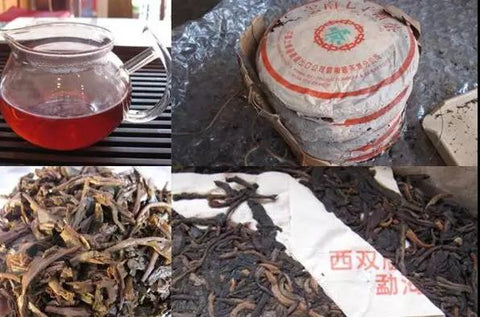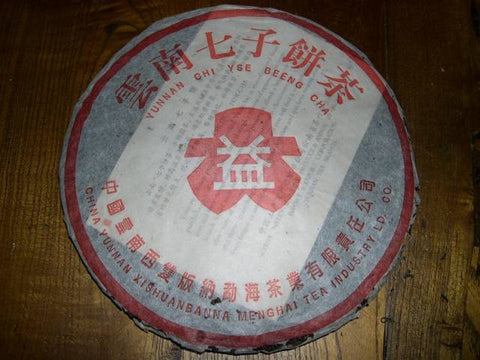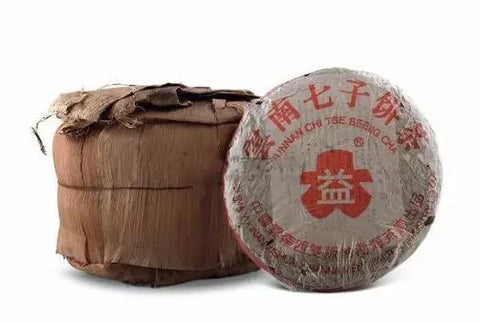Some Star Products during 7542 Series.
During the last century, all puerh tea factories were nationalized under the China National Native Produce & Animal By-Products Import & Export Corporation (CNNP).
To standardize the puerh tea industry, CNNP introduced a unique numbering system for tea products, based on the recipe, the grade of tea materials used, and the producing factory.
Officially established around 1973 and recognized both domestically and internationally within three years, this system became a hallmark of the industry.
Take the example of '7542': '75' indicates that the recipe was initiated in 1975. The following '4' denotes the use of 4th-grade tea materials as the primary component. The final '2' signifies that this tea was produced by the Menghai Tea Factory.
Among the many standout products in the '7542' series, the first one, known as '88 Qing Bing', is particularly noteworthy.
It's also referred to as '88青饼', '八八青饼', or '88青' in Chinese characters, '88 Qing Bing' in Pinyin, and translated to '88 Green Cake' in English.

(pic source: https://mp.weixin.qq.com/s/Fd2JuvhrUx231Hq2x-H77Q)
The '7542' series, produced around 1988 to 1992, is highly regarded. Some batches of this tea were stored in relatively dry conditions in Hong Kong, and over the years, they have developed a significantly enhanced flavor. This improvement in taste has led to a gradual increase in market recognition.
After extensive aging, the characteristic aged flavor becomes pronounced and lingers. The tea boasts an amber hue, notable for its brightness and clarity. It offers a sweet taste, with a lingering tea flavor that resonates in the mouth and deep into the throat.
- '94 Shi Ye Qing'
(Also known as '94事业青' in Chinese characters)

(pic source: https://mp.weixin.qq.com/s/Fd2JuvhrUx231Hq2x-H77Q)
Produced in 1994, this tea gained the nickname '94 Shi Ye Qing' or '94 Qing' due to a printing error. The traditional Chinese character for 'leaf' (枼) was mistakenly printed as 'business' (業). While not as renowned as the first one, '88 Qing Bing', it still holds a unique place in the series.
- '96 Zi Da Yi' (Purple Dayi)
The '96 Zi Da Yi' was released in 1996 and is notable as the first product featuring the newly registered brand name '大益' (Da Yi or TAE TEA). It earned the nickname '96 Zi Da Yi' (96 Purple Dayi) because of the purple ink used on its wrapper, which is also sometimes referred to as 'Rose Da Yi' due to the rose-like hue of the purple. Additionally, the 'Nei Fei' (the inner paper file) pressed into this tea cake is printed in a reddish color.

(pic source: https://mp.weixin.qq.com/s/Fd2JuvhrUx231Hq2x-H77Q)
Following the year 2001, other editions of 'Zi Da Yi' were also released, continuing the tradition of using purple on the wrapper. Additionally, both the mark and the text on the 'Nei Fei' (the inner paper file) of these editions are printed in purple as well.
- '97 Shui Lan Yin' (97 Water Blue Mark)

(pic source: https://mp.weixin.qq.com/s/Fd2JuvhrUx231Hq2x-H77Q)
The '97 Shui Lan Yin' is known for its thin wrapper and the use of water blue color to print the Chinese character for 'tea' (茶), hence its nickname. This tea has aged well, offering an old tea flavor with notes of plum fragrance. It is remarkable for its Huigan (returning sweetness) and long-lasting saliva production.
- 'Wu ® Hong Da Yi' (Red Dayi without ®)
This tea, produced around the year 2000, coincides with the period when the Menghai Tea Factory was in the process of registering 'Da Yi' as a brand, but had not yet received official certification.
There are two variations of this tea, distinguishable by the printed words 'CHI TSE' (Seven Sons) and the misspelled 'CHI YSE'.
'CHI TSE'...

(pic source: https://www.sohu.com/a/278362990_556647)
"CHI YSE"

(pic source: https://m.sohu.com/a/243014923_100178011)
6. "2001 Jian Ti Yun 7542" (2001 Year Simplified Cloud 7542)

(pic source: https://mp.weixin.qq.com/s/y-ki6jf4ufBXuo0nDtZ7vQ)
The characters for '云南七子饼茶' (Yunnan Seven Sons Cake Tea) on this tea are printed in simplified Chinese. It is renowned for its pleasing aroma, bright and clear tea liquor color, thick and robust flavor, and a Huigan (returning sweetness) that lingers long in the mouth.
- '501 Bai Bu Tiao' (501 White Strip)
This is the first batch of the 7542 series released in 2005. There are rumors that this tea was made using older tea materials stockpiled in the Menghai Tea Factory, which was privatized in 2004 by the Bowen Group.

(pic source: https://mp.weixin.qq.com/s/Fd2JuvhrUx231Hq2x-H77Q)
The '501 Bai Bu Tiao' (501 White Strip) gets its nickname from the white strip used to bind each outer bamboo basket, similar to the use of carton. This strip features the handwritten Chinese characters '责任公司说明书' (Introduction of Liability Company). Additionally, the phrase '有限责任公司' (Limited Liability Company) is printed on the 'Nei Piao' (Inner Paper File).
In contrast, other batches of the 7542 series released in the same year are distinguished not just by the white strip, but also by the words '勐海茶厂' (Menghai Tea Factory) printed on their 'Nei Piao'.
The first batch is considered superior to subsequent releases in terms of taste and aroma. It offers a high fragrance, a thick and robust tea flavor, smokiness, and a well-balanced profile.
- '901 Bao Shi Lan 7542' (901 Blue Diamond 7542)

(pic source: https://mp.weixin.qq.com/s/y-ki6jf4ufBXuo0nDtZ7vQ)
The first batch of '901 Bao Shi Lan 7542' was produced in 2009. It features simplified Chinese characters printed in blue on the wrapper, and the tea is packed using bamboo leaves for each stack, followed by a final packaging in carton. Known for its rich taste and exceptional quality, this tea has been affectionately nicknamed the 'Blue Diamond 7542'.
- '80th 7542' (80 Years Commemorative 7542)
This special edition was released in 2020 to celebrate the 80th anniversary of the Menghai Tea Factory.

This tea is a blend of aged and new tea leaves. It boasts a high fragrance and has just a hint of bitterness and astringency. The Huigan (returning sweetness) and saliva production are pronounced and come with a robust strength. The tea has a strong Chaqi and is notably sweet, showcasing the distinct characteristics of Bulang tea.
<To be continued by Dayi>
